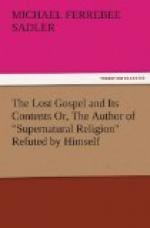The supernatural fact respecting Christ to which the earliest Epistles of St. Paul most prominently refer, was His Resurrection as the pledge of ours, and this is the fact respecting Christ which is put most prominently forward by Clement, and for the same purpose. The First Epistle to the Corinthians is referred to by Clement in the words:—
“Take up the Epistle of the Blessed Apostle Paul. What did he write to you at the time when the Gospel first began to be preached? Truly, under the inspiration of the Spirit ([Greek: pneumatikos]) he wrote to you concerning himself and Cephas and Apollos, because even then parties had been formed among you.” (Ch. xlvii.)
The other reproductions of the language of St. Paul’s Epistles are numerous, and I give them in a note. [194:1] The reader will see at a glance that the Theology or Christology of Clement was that of the earliest writings of the Church of which we have any remains, and to these he himself frequently and unmistakably refers.
The earlier Epistles of St. Paul, as those to the Thessalonians, Galatians, Corinthians, and Romans, are acknowledged on all hands, even by advanced German Rationalists, to be the genuine works of the Apostle Paul; indeed one might as well deny that such a man ever existed as question their authenticity. The First Epistle to the Corinthians, which is the longest and most dogmatic of the earlier ones, cannot have been written after the year 58. In a considerable number of chronological tables to which I have referred, the earliest date is the year 52, and the latest 58.
To the First Epistle to the Thessalonians, which is undoubtedly the earliest of all, the earliest date assigned is 47, and the latest 53.
Now it is ever to be remembered that in each of these—the First to the Thessalonians and the First to the Corinthians—we have enunciations of the great crowning supernatural event of Scripture—the Resurrection of Christ and our Resurrection as depending upon it, which are unsurpassed in the rest of Scripture.
So that in the first Christian writing which has come down to us, we have the great fact of Supernatural Religion, which carries with it all the rest.
The fullest enunciation of the evidences of the Resurrection is in a writing whose date cannot be later than 58, and runs thus:—
“Moreover, brethren, I declare unto you the Gospel which I preached unto you, which also ye have received, and wherein ye stand; by which also ye are saved, if ye keep in memory what I preached unto you, unless ye have believed in vain. For I delivered unto you first of all that which I also received, how that Christ died for our sins according to the Scriptures; and that He was buried, and that He rose again the third day according to the Scriptures. And that He was seen of Cephas, then of the twelve. After that [196:1] He was seen of above five hundred brethren at once, of whom the greater part remain




